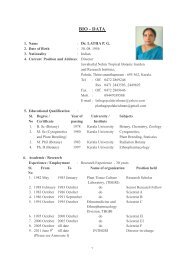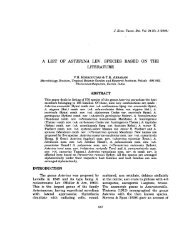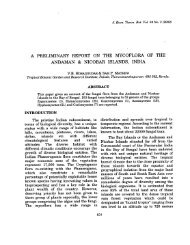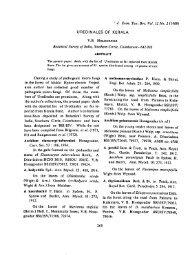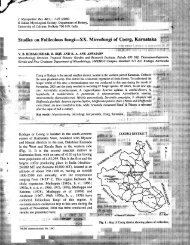Some new foliicolous ascomycetes from northern India - TBGRI
Some new foliicolous ascomycetes from northern India - TBGRI
Some new foliicolous ascomycetes from northern India - TBGRI
You also want an ePaper? Increase the reach of your titles
YUMPU automatically turns print PDFs into web optimized ePapers that Google loves.
<strong>India</strong>n Phytopath. 57 (3) : 287-295 (2004)<br />
<strong>Some</strong> <strong>new</strong> <strong>foliicolous</strong> <strong>ascomycetes</strong> <strong>from</strong> <strong>northern</strong> <strong>India</strong><br />
SURESH J. GAWANDE, D.K. AGARWAL and V.B. HOSAGOUDAR*<br />
Division of Plant Pathology, <strong>India</strong>n Agricultural Research Institute, New Delhi 110 012<br />
'Tropical Botanical Garden and Research Institute, Palode, Kerala 695 562<br />
ABSTRACT: In the present paper five <strong>new</strong> species and three varieties of <strong>foliicolous</strong> ascomycetous fungi have<br />
been described <strong>from</strong> various localities of Northern <strong>India</strong>. These are Asterina lawsonii on Lawsonia alba L.,<br />
Meliola dehradunensis on Alstonia scholaris (L.) R. Br., M. capensis (Kalch. and Cooke) var. dimocsrpi var.<br />
novo on Dimocarpus longan L., M. desmodii triangularis on Desmodium triangularae (Retz.) Merr., M. desmodii<br />
triquetri on D. triquetrum DC., M. panici Earle. var. vetivericola var. novo on Vetiveria zizanoides (L.) Nash, M.<br />
strychnii-nuxvomicae on Strychnos nux-vomica L. and Pleospora vagans var. aconitii var. nov. on Aconitum<br />
sp.<br />
Key words: Ascomycetes, <strong>foliicolous</strong> fungi, Asterina, Meliola, Pleospora<br />
The specimens were collected <strong>from</strong> Northern alternate, globose to ovate, entire, rarely slightly<br />
regions of <strong>India</strong> comprising parts of Himachal angular, 5.0-8.0 X 4.0-6.0 ~m. Thyrothecia scattered,<br />
Pradesh, Uttaranchal and Delhi. Of these collections, often loosely grouped, orbicular, up to 95.0 ~m<br />
one <strong>new</strong> species of Asterina, four <strong>new</strong> species, two diameter, stellately dehisced at the centre, crenate<br />
<strong>new</strong> varieties of Meliola and a <strong>new</strong> variety of at the margin. Asci few to many, globose,<br />
Pleospora have been described and illustrated. octosporous, up to 25.0-35.0 ~m in diameter,<br />
1. A s.erlna ~. l .. G d & A I<br />
aWSOnll awan e garwa, sp..<br />
ascospores oblong,<br />
.<br />
brownish conglobate,<br />
(PI t 1 d F . 1 ) uniseptate, constricted at the septum, 15.0-19.0 X<br />
novo a e an Ig.<br />
6.0-10.0 ~m .<br />
Coloniis fere epiphyllae, tenuae, confluentibus, .<br />
ad 3 mm in diam. Hyphae rectus vel flexuosus, SEM studies show that the surface of<br />
ramosae adversum, alternata vel irregulares et acuta thyrothecia is echinulated, its cells are forming<br />
vel late angulus, laxae reticulatae cellulae 17.0- ridges and furrows and projecting upwards. SEM of<br />
25.0 X 4.0-6.0 ~m. Hyphopodiales unicellulares, ascospores and hyphae are in confirmity with the<br />
numerosi, alternata, globosa vel ovata, integer, raro observations of light microscopy.<br />
d. parce angulares, , 5.0-8.0 X 4.0-6.0 ~m. Thyrotheciae Th .<br />
I f . b . I d 95 0 lessen<br />
(1913)<br />
repo<br />
rt<br />
e<br />
d A<br />
.<br />
/,<br />
awsomae<br />
. P<br />
.<br />
H<br />
enn.<br />
i Issemlnatus, axe asclatus, ar ICU ares a . & E N L .. L. ! d. t II t t .. A . . ym. on . Inermls Inn. However, the<br />
~m lam., sea us, crenatus e marglnls. SCI '. .<br />
I' I It . I b t d 25 0 35 0 present collection clearly differs <strong>from</strong> A. lawsomae<br />
a Igove<br />
d.<br />
mu I, go<br />
A<br />
osus, oc osporous<br />
bl<br />
a<br />
b<br />
. -. ..<br />
in size f 0 ascospore. (17 0 20 0 X 6 5 8 0 -. . -. ~m ) an d<br />
~m lam. scospore 0 on gus, runnus,<br />
I b t . t t t . t t t t<br />
cong 0 a us, unlsep a e, cons rlc 0 e sep a um,<br />
15.0-19.0 X 6.0-10.0 'm.<br />
~<br />
. . .<br />
in having echinulate surface of ascospore. Song<br />
.<br />
and Tal (2002) reported A. lawsonicola on Lawsonia<br />
alba L. <strong>from</strong> China. The present material differs<br />
Colonies mostly epiph~llous, thin, confluent, with A. lawsonicola in having relatively smaller<br />
upto 3 mm in diameter. Hyphae straight to flexuous, thyrothecia (150.0~m) and ascospores size '( 15.0-<br />
branching opposite, alternate to irregular at acute 17.0 X 5.5-8.0 ~m). On the basis of these differences<br />
to wide angles, loosely reticulate, cells 17.0 -25.0 a <strong>new</strong> epithet "Iawsonii" has been proposed for the<br />
X 4.0-6.0 ~m. Hyphopodia unicellular, many, proposed <strong>new</strong> species.
288 <strong>India</strong>n Phytopathology [Vol. 57(3) : 2004]<br />
8 b<br />
Q --'-<br />
=~<br />
~<br />
"<br />
Cd'! ~<br />
e<br />
-"';c<br />
-18ft<br />
Fig. 1. Aster;na lawson;;<br />
.,,~<br />
6 '.i:;<br />
(( ,,;,;;<br />
a: Hyphopodia, b: Thyrothecium, c: Ascospores<br />
t<br />
Plate 1. Aster;na lawson;; Colonies amphigenous mostly epiphyllo s<br />
a) LM of thyrothecia (100X), b) SEM of thyrothecia, d I ty t 4 '. d.<br />
h h u,<br />
c) LM of ascospores (400X), d) SEM of en~e, ve ve , up 0 mm In lame er, yp ae<br />
ascospores, e) SEM of hyphae straight, branching opposite, at acute to wide<br />
angle, loosely to closely reticulate, 15.5-22.0 X 5.5-<br />
7.0 I.Jm. Hyphopodia opposite, crowded to sparse,<br />
Material examined: On living leaves of 12.0-14.0 I.Jm long; stalk cells cuneate, 3.0-5.0 I.Jm<br />
Lawsonia alba L. (Ly1hraceae), Delhi, 16 May, long; head ceJls concid, rarely broadly rounded at<br />
2001, Coil., S.J. Gawande, HCIO -44910 (typus). the apex, entire, 7.0-12.0 X 6.0-9.0 I.Jm. Phial ides<br />
.. . mixed with hyphopodia, alternate to opposite,<br />
2. Mellola capensls (Kalch and Cooke) Theiss. II.f 13 0- 10 0 M I .<br />
15 5 X 6 0-<br />
d . . G d A I & H ampu I orm, . . . . I.Jm. yce la<br />
var. Imocarpl awan e, garwa osag. .<br />
(PI t 2 d F . 2) setae scattered, straight, acute to obtuse at the<br />
var. novo a e an Ig. . 390 0 420 0 I P . h .<br />
tip, . - . I.Jm ong. erlt ecla verrucose,<br />
Coloniis amphigenae plerumque epiphyllae, loosely grouped, upto 177 I.Jm in diameter.<br />
densae, velvetae, ad4 mm diam., Hyphae rectae, Acospores brown, smooth, oblong, 4 septate,<br />
ramosae oppositae, et acute que vellaxe, laxe vel constricted, 32.0-38.0 X 12.0-15.0 I.Jm in size.<br />
anguste reticulatae cellulae, 15.5-22.0 X 5.5 -7.0<br />
. .<br />
I.Jm. Hyphopodla Opposlta, congestus vel sparsus,<br />
.<br />
12.0-14.0 I.Jm longa; cellulae basllares cuneatae,<br />
3 0 5 0 I . II I . I .d.<br />
. -. I.Jm onga, ce u ae aplca es conci ,<br />
. .<br />
plerumque late roundata et aplce, Integratae 7.0-<br />
120 X 6090 Ph. I.d . t . t<br />
. . -. I.Jm. la I es In ermlx ae co<br />
P .th . d .<br />
erl ecla appeare verrucose In na ture un der<br />
SEM .th .t rf II .d d . t.<br />
WI I S su ace ce s conol an proJec Ing<br />
.<br />
outside. The morphology of ascospores, hyphae,<br />
d h h d ' , f .t .<br />
an yp opo la was In con orml y WI th th e<br />
b t. f I. ht .<br />
o servalonso Ig microscopy.<br />
hyphopidiae, altematae vel oppositae, ampulliformes, Hosagoudar and Goos (1990) reported M.<br />
13.0-15.5.0 X 6.0-10.0 I.Jm. Setae myceliales capensis on leaves of Nephelium long an Lour.<br />
dispersae, recta, acuta vel obtusa at apice, 390.0- However, the present studies reveal that M. capensis<br />
420.0 I.Jm longa. Perithecia verrucosus, dispersa var. dimocarpi differs <strong>from</strong> M. capensis in length<br />
vel laxe aggregata, ad 177.0 I.Jm diam. Ascospora and morphology of mycelial setae. Mycelial setae<br />
brunnus, oblong a, 4-septate, constrictae, 32.0-38.0 are dentate in M. capensis while these are acute in<br />
X 12.0-15.0 I.Jm. var. dimocarpi and the length is 658.0 I.Jm in M.<br />
I<br />
I
~':~i,~:';{~<br />
[Vol. 57(3) : 2004] <strong>India</strong>n Phytopathology 289<br />
a b"~<br />
c d<br />
I:.., t': . ,'..<br />
.~;.:'<br />
I:~;.. '.', .. . ,.::: ..j,<br />
."<br />
C '."<br />
e Fig. 2. M. capensis var. dimocarpi<br />
Plate 2. M. capensis var. dimocarpi A: Hyphopodia, b: Phial ides, c: Ascospore,<br />
\-i<br />
~o J1~<br />
a) SEM of ascospore, b) LM of ascospore d: Mycelial setae<br />
(400X) , c) SEM of hyphae d) LM of hyphae<br />
(100X), e) SEM of perithecia<br />
myceliales rectus vel obtusus, non ramosus, ad<br />
. . . . 614.0 I.Jm longa. Perithecia dispersa, ad 137.0 I.Jm<br />
c~pensls ,-:,her~as I~ IS 390.0- 420.0.l.Jm In the va~. diam. Ascospora brunnus, oblonga, cylindrica,<br />
dlmocarpl. Perlthecla are scattered In M. capensls subconstricta at septata, 32.0-40.0 X 10.0-18.0<br />
whereas they are loosely grouped in M. capensis I.Jm.<br />
var. dimocarpi. On the basis of these variations a<br />
<strong>new</strong> epithet 'dimocarpi' is proposed, thus warranting Colonies epiphyllous, dense, velvety, confluent,<br />
creation of a <strong>new</strong> variety on Dimocarpus longan. hyphae straight to flexuous, branching opposite to<br />
. . . . alternate at acute to wide angle, cells 22.0-34.5 X<br />
Material examined: On living leaves of 6.0-9.0 bJm. Hyphopodia alternate, opposite, straight<br />
Dimocarpus longan L. (Sapindaceae ), Dehradun, to usually curved, antrose, 12.5-19.0 I.Jm long, stalk<br />
Uttaranchal., 23rd Oct. 2002, Coil., S.J. Gawande, cells cuneate, 2.0-6.50 I.Jm long; head cells ovate,<br />
HCIO- 44911 (typus). globose, 10.0-12.5 X 8.0-10.0 I.Jm. Phial ides mixed<br />
3. Me/io/a dehradunensis Gawande & Agarwal with hyphopodia, alternate to opposite, ampulliform,<br />
sp. novo (Fig.3 and Plate 3) 15.0-20.0 X 9.0-11.0 I.Jm. Mycelial setae straight to<br />
obtuse, simple, upto 614.0 I.Jm long. Perithecia<br />
Coloniis epiphyllae, densae, velutinus, confluent, verrucose, loosely grouped, upto 137.0 I.Jm in<br />
ad 5 mm diam. Hyphae rectus vel flexuosus, diameter. Ascospore brownish, smooth, slightly<br />
oppositus vel alternatus ad acuta vel latus angulus constricted at the septa, 32.0-40.0 X 10.0-18.0 I.Jm<br />
ramosus, cellulae 22.0-34.5 X 6.0-9.0 I.Jm. in size.<br />
Hyphopodia alternata, opposita, recta vel plerumque<br />
curvata, 12.5-19 .0 I.Jm 10Qga; cellulae basilares SEM revealed perithecial bodies verrucose in<br />
cuneata 2.0-6.5 I.Jm longa; cellulae apicales ovata, nature with its surface cells conoid and projecting<br />
globosa, 10.0-12.5 X 8.0-10.0 I.Jm. Phial ides outside. The morphology of ascospores, hyphae<br />
intermixtae hyphopodiae, alternatae vel oppositae, and hyphopodia are in conformity with the<br />
ampuliformae, 15.0-20.0 X 9.0-11.0 I.Jm. Setae observations of light microscopy.<br />
b<br />
d
290 <strong>India</strong>n Phytopathology [Vol. 57(3) : 2004]<br />
~i<br />
;"'!<br />
': a b<br />
""<br />
,<br />
"<br />
:: .<br />
.' , f ~ - I<br />
, 511~<br />
C d<br />
d<br />
Plate 3. M. dehradunensis<br />
Fig. 3. M. dehradunensis a) SEM of ascospore<br />
a: Hyphopodia, b: Phialides, c: Ascospore, b) LM of ascospore (400X)<br />
d: Mycelial setae c) LM of hyphae (100X)<br />
d) SEM of hyphae<br />
Thite and Kulkarni (1978) and Hosagoudar and<br />
Goos (1991) reported M. alstoniae on Alstonia 6.0-9.0 X 6.0-1 0.0 ~m. Phialides intermixtae<br />
scholaris <strong>from</strong> Western and Southern <strong>India</strong>. The hyphopodiae alternatae vel oppositae, ampuliformae<br />
present studies revealed that M. dehradunensis 10.0-12.0 X 6.0-8.5 ~m. Setae mycsliales aggregatae<br />
differs with M. alstoniae in colony characters while circa perithicia, rectus vel curvatus, dentatae, ad<br />
as colonies are amphigenous in M. alstoniae they 270.0 ~m longae. Perithicia dispersa, verrucosae,<br />
are epiphyllous in M. dehradunensis. Phial ides are ad 90.0 ~m diam., Ascosporae brunnus, cylindricae<br />
borne on separate mycelial branches in M. alstoniae vel oblongae, sub constrictae, 40.0-45.0 ~m 15.0while<br />
in M. dehradunensis these are mixed with 18.0 ~m.<br />
hyphopodia. T.he size of perithecia (207.0 ~m), Colonies epiphyllous, thin, crustose up to 2<br />
length of mycelial setae (441.0 ~m~ and ascospores mm in diameter. Hyphae undulate, branching<br />
(30.0-3?0~, 12.0-15.0 ~~),,~Iso differ. Therefore, a opposite at wide angles, loosely to closely reticulate<br />
<strong>new</strong> epl~het 'dehradunensls IS proposed on Alstonia cells, 20.0-39.0 X 5.5- 7.0 ~m. Hyphopodia alternate,<br />
scholans. opposite curved, mostly antrose, 8.0-12.0 ~m long;<br />
Material examined: On living leaves of Alstonia stalk cell cylindrical to cuneate, 2.0-3.5 ~m long;<br />
scholaris (L.) A.Br. (Apocynaceae). Dehradun, head cells globose, ovate, entire, 6.0-9.0 X 6.0-10.0<br />
Uttaranchal, 23rd Oct., 2002, Coli., S.J. Gawande, ~m. Phialides mixed with hyphopodia, alternate to<br />
HCIO - 44913 (typus). opposite, ampuliform, 12.0-15.0 X 6.0-8.5 ~m.<br />
Mycelial setae grouped around perithecia, straight<br />
4. Meliola desmodii-triangularis Gawande & to curved, dentate, upto 270.0 ~m long. Perithecia<br />
Agarwal sp. novo (Plate 4 and rig. 4) scattered, verrucose, up to 90.0 ~m in diameter.<br />
Coloniis epiphyllae, rarae, crustosus ad 2 mm Ascos~ore brownish, smooth, obovoidal, slightly<br />
diam. Hyphae undatus, oppositus ad latus angulus constricted 40.0-45.0 X 15.0-18.0 ~m.<br />
ramosus, cellulae laxe vel anguste reticulatae, Perithecia revealed its verrucose nature with its<br />
20.0-39.0 X 5.5-7.0 ~m. Hyphopodia alternata, surface cells conoid and projecting outside under<br />
opposita, cu rvata , fere antrosa 8.0-12.0 ~m longa; SEM. The morphological observations of ascospores,<br />
cellulae basilares cylindrica vel cuneata 2.0-3.5 ~m hyphae and hyphopodia are in conformity with the<br />
longa; cellulae apicales globosae, ovatae, integrae observations of light microscopy.<br />
-
[Vol. 57(3) : 2004] <strong>India</strong>n Phytopathology 291<br />
a<br />
,<br />
, ..<br />
Fig. 4. M. desmodii-traingularis<br />
a: Hyphopodia, b: Phial ides, c: Ascospore,<br />
d: Mycelial setae<br />
Material examined: On living leaves of<br />
Desmodium triangularae (Retz.) Merr.<br />
(Papilionaceae), Dehradun, Uttaranchal; 24 Oct.,<br />
2002, Coil., S.J. Gawande, HCIO. 44914 (typus).<br />
5. Me/iota desmodii-triquetri Gawande, Agarwal<br />
& Hosag. sp. novo (Plate 5 and Fig. 5)<br />
Coloniis amphigenae, plerumque epiphyllae,<br />
densae, ad 4 mm diam. Hyphae subrectus,<br />
b oppositus and latus angulus ramosus, cellulae<br />
25.0-34.5 X 5.0-9.0 I.Jm. Hyphopodia alternata,<br />
Plate 4. M. desmodii-triangularis opposita, fere curvata, antrosa, 12.0-15.0 I.Jm longa;<br />
a) SEM of perithecia with ascospores cellulae basilares cylindricae vel cuneatae, 2.0-5.0<br />
b) SEM of hyphae I.Jm longa; ceiliae apicales globosae, ovatae,<br />
. .<br />
Hansford (1961), Srlnlvasulu (1974), Hosagoudar<br />
integrate 9.0-11.0 X 8.5-13.0 I.Jm; Phial ides borne in<br />
discretae ramosae mycelium, opposi!ae,<br />
a~d Goos (1991) r~ported M. bicomison ~es~odium ampuliforme, 12.0-14.0 X 6.0-9.0 I.Jm. Setae<br />
trIquetrum, D.. tnangularae and D. teftfofta. Th.~ myceliales aggregatae, circaperithecie, nonramosa,<br />
p~esent .stu?les showed ~hat.~. des~odll- rectus, acuta vel obtusa and apicem, ad 270.0 I.Jm<br />
tna~gu/~ns differs fro.m M. ~/cor~/s In th~ size of longa. Perithecia dispersa vel laxe aggregate, ad<br />
perlth~cla (223..0 I.Jm In M. blcorms). The tlPtOf.the 130.0 I.Jm diam. Ascosporae brunnus, obovoidae<br />
mycelial setae IS acute to obtuse and are s.ralght vel oblongae, constrictae 31.0-38.0 X 12.5 -15.5<br />
in M. bicornis whereas ~he tip of the ~~c~lial set~e<br />
is dentate and curved In M. desmodll-tnangulans.<br />
I.Jm.<br />
The size of ascospores also significantly differs Colonies amphigenous, mostly epiphyllous,<br />
<strong>from</strong> M. bicomis (33.0-40.0 X 12.0-15.5 I.Jm) whereas dense, up to 4 mm in diameter. Hyphae substraight,<br />
it is 43.0-48.0 X 15.0-18.0 I.Jm in M. desmodii- branching opposite, at wide angles, cells 25.0-34.5<br />
triangularis. Based on these variations a <strong>new</strong> species X 5.0-9.0 I.Jm. Hyphopodia alternate, opposite,<br />
desmodii-triangularis on Desmodium triangularae is usually curved, antrose 12.0-15.0 I.Jm long; head<br />
proposed. cells globose, ovate, entire, 9.0-12.0 X 8.5-13.0<br />
l1
~;~i~J~,;c. !<br />
t~"':! .<br />
,.. ,,' ~i'<br />
! 292 <strong>India</strong>n Phytopathology [Vol, 57(3) : 2004]<br />
,<br />
i<br />
" ,<br />
a b "<br />
",<br />
,::<br />
" ' "<br />
:::! ,:: ~,~:<br />
:: ~,',':' '~:,:<br />
d" ,.,~<br />
Cd:': c<br />
"<br />
Fig. 5. M. desmodii-triquetri<br />
a: Hyphopodia, b: Phial ides, c: Ascospore,<br />
d: Mycelial setae<br />
e<br />
Plate 5. M. desmodii-triquetri desmodii triquetri while in the case of M. bicornis<br />
a) LM of perithecia (100X) ascospores are obovoidal only. The tip of mycelial<br />
b) SEM of perithecia setae is obtuse in M. bicornis whereas it is acute<br />
c) SEM of ascospore in M. desmodii-triquetri. Mycelial branching is acute<br />
d) LM of ascospore (400X) in M. bicornis but in M. desmodii triquetri it is at<br />
e) LM of hyphae (400X) wide angles. A <strong>new</strong> epithet "desmodii-triquetri" has<br />
, ,<br />
~m; stalk cells, cylindrical to cuneate, 2.0-5.0 ~m<br />
been proposed based on these variations. Thus<br />
warranting creation of a <strong>new</strong> species on Desmodium<br />
10ng.Phialides borne on mycelial branches, opposite,<br />
ampulliform, 12.0-18.0 X 6.0-10,0 ~m. Mycelial<br />
triquetrium DC,<br />
setae grouped around perithecia, simple, straight, Material examined: On living leaves of<br />
acute at the tip, up to 270.0 ~m long. Perithecia Desmodium triquetrium DC. (Papilionaceae),<br />
verrucose, grouped, upto 130.0 ~m in diameter, Dehradun, Uttaranchal, 240ct.,2002, Coli., S.J,<br />
ascospore brownish, smooth, obvoidal to ablong, Gawande, HCIO 44915 (typus)<br />
constricted at septa, 31,0-38.0 X 12.5 -15.5 ~m 6. Me I 10 " 1 a panlcl . " Ear Ie var. ve t Ivenco ". 1a<br />
Perithecia revealed its verrucose nature with its Gawande, Agarwal & Hosag, var. novo (Plate 6<br />
surface cells conoid and projecting outside under and Fig. 6)<br />
SEM. The'observations of ascospores, hyphae and<br />
h h d ' , f 't 'th th b t .<br />
yp opo la are In con orml y WI e 0 serva Ions<br />
f I' ht '<br />
0 Ig microscopy.<br />
C I " , h II d 2 4 d'<br />
0 OnilS eplp y ae, ensae, - mm lam.<br />
H h I b '<br />
yp ae rectus ve su rectus, opposite acuteque<br />
,<br />
vellaxe ramosae, {jense'retlculatae, cellulae 22,0-<br />
Hansford (1961), Srinivasulu (1974), Hosagoudar 60.0 X 7.0-9.0 ~m. Hyphopodia alternata, rectus vel<br />
and Goos (1991) reported Meliola bicornis on curvatus, antrosa vel recurvata, 17,0- 24.0 ~m<br />
Desmodium triquetrum, D. triangularae, D. telifolia longa; cellulae basilares 6,0-1 0.0 ~m longae, cellulae<br />
DC. and 0, velutinium (Willd.) DC. The present apicales ovatae vel globosae, integral, angularae<br />
studies showed that M. desmodii-triquetri differs vel sublobatae, 11,0-17.0 X 12,0-15.5 ~m, Phialides<br />
<strong>from</strong> M, bicornis in the size of perithecia (223.0 borne in discretae ramose mycelium alternata vel<br />
~m). The perithecia are scattered in M, bicornis adversa, ampuliformae, 18.0-20.0 X 7.0-10.0 ~m.<br />
Wint. where as they are grouped in M. desmodii- Setae myceliales rectus, nonramosa, acuta, ad<br />
triquetri; ascospores are oblong to obovoidal in M, 300.0 ~m longa. Peritheciae fere agg regatae ,
-- ~<br />
[Vol. 57(3) : 2004] <strong>India</strong>n Phytopathology 293<br />
, a t~;c" v<br />
i 1<br />
50 pm<br />
Fig. 6. M. panici var. vetivericola<br />
b c a: Hyphopodia, b: Phial ides, c: Ascospore<br />
Plate 6. M. panici var. vetivericola , , ,<br />
a) SEM of hyphae ascospore, 38.0-45.0 X 15.0-18.0 I.Jm In M, panic!<br />
b) LM of ascospore (400X) var. vetivericola where as it is 34.0-37.0 X 12.0 -<br />
c) SEM of ascospore 14.0 I.Jm in M. panici. The tip of mycelial setae is<br />
acute in var. vetivericola, whereas it is obtuse in M.<br />
verrucosae, ad 149.0 I.Jm diam. Ascosporae brunnus, panici. These characters are distinct <strong>from</strong> any<br />
obovoidae, oblongae, septatae, constrictae at other existing varieties of M. panici. A <strong>new</strong> epithet<br />
septata, 38.0-45.0 X 15.0-18.0 I.Jm. 'vetivericola' is proposed on the basis of these<br />
, ,<br />
Colonies eplphyllous,<br />
,<br />
dense, 5.0-10.0 mm In<br />
variations.<br />
variety,<br />
Thus warranting a creation of a <strong>new</strong><br />
diameter, hyphae straight to substraight, branching<br />
opposite at acute to wide angles, closely reticulate, Material examined: On living leaves of<br />
cells 22,0- 60.0 X 7.0-9.0 I.Jm. Hyphopodia alternate, Vetiveria zizanoides (L.) Nash. (Graminae)<br />
opposite, straight to curved, antrose to recurved, Dehradun, Uttaranchal., 240ct., 2002, Coli., S.J.<br />
17.0- 24.0 I.Jm long; stalk cells 6.0-10.0 I.Jm long; Gawande, HCIO. 44916 (typus)<br />
head cells ovate to globose, entire, angular to<br />
bl b t 11 0-<br />
17 0 X 12 0-15 5 Ph' I'd<br />
su 0 ae, .. .. I.Jm. lal es<br />
borne on a separate mycelial . branch, alternate to<br />
7.<br />
. .. .<br />
Mehola strychnll-nux vomicae Gawande,<br />
A I & H (F'<br />
9 arwa osa 9 . s P . novo I. 9 7)<br />
opposite, ampuliform, 18.0-20.0 X 7,0-10.0 I.Jm. Coloniis amphigenae, plerumque hypophyllae,<br />
Mycelial setae, straight, simple, acute, up to 300.0 subdensae, ad 2 mm diam., confluentes. Hyphae<br />
I.Jm long. Perithecia mostly grouped, verrucose, subrectae, flexuosae vel anfractuae, opposite vel<br />
upto 149.0 I.Jm in diameter. Ascospores brownish, irregulariter acuteque vel 1axe ramosae, laxe<br />
smooth, obovoidal, oblong, 4 septate, constricted reticulatae, cellulae 16.0-20.0 X 6.0-8.0I.Jm.<br />
at septa, 38.0-45.0 X 15.0-18.0 I.Jm. Hyphopodia alternata, minusve 1 % opposita,<br />
P 'th ' I d .t t .th .t<br />
erl ecla revea e I s verrucose na ure WI IS,<br />
rf II 'd d ' t ' t .d b<br />
su ace ce s conol an proJec Ing ou Sl e y<br />
SEM Th b t' f h h d<br />
. e 0 serva Ions 0 ascospores, yp ae an<br />
h h d' , f 't 'th th It<br />
yp opo la are In con orml y WI e resu s<br />
bt ' d b I, ht '<br />
0 alne y Ig microscopy.<br />
ant rosa, subantrorsa vel recurvata, 17.0-26.0 I.Jm<br />
,<br />
longa; cellulae basllares cyllndraceae vel cuneatae,<br />
,.<br />
6.0-10.0 I.Jm longae, cellulae aplcales ovatae,<br />
. ,<br />
oblongae, Integrae vel agnularlae, attenuatae vel<br />
, ,<br />
truncatae ad aplcem, 11.0-16 X 8.0-12.0 I.Jm.<br />
Ph ' I'd h h d" t '<br />
la I es numerosae, yp opo la In ermlx tae ve I<br />
The present material is compared with M. oppositae, ampulliformes, 12.0-20.0 X 6.0-8.0 I.Jm.<br />
panici Earle described on Centotheca lappacea Setae myceliales dispersae vel juxta perithecia<br />
(HCIO 30555) & is found to differ in size of aggregatae, simplices, rectae, curvulae vel
F "'..,<br />
, ,<br />
- ,jJ;i """ -""<br />
I'"<br />
"'1<br />
ii, 294 <strong>India</strong>n Phytopathology [Vol, 57(3) : 2004]<br />
I I<br />
! :"<br />
~~<br />
Fig. 8. Pleospora vagans var. acotinii<br />
" a: Asci, b: Ascospore, c: Perithecium<br />
~ ~ c, '" The results obtained showe~ that has comparati~ely<br />
d '!, :~, closely arranged hyphopodla, shorter and straight<br />
t~~ j, to uncinate mycelial setae which differ <strong>from</strong> the<br />
'" C known species. Based on these characters a <strong>new</strong><br />
Fig. 7. M. strychinii-nux vomici species of Meliola with the epithet" strychnii-nux<br />
a: Hyphopodia, b: Phial ides, c: Ascospore,<br />
d: Mycelial setae<br />
vomicae is proposed.<br />
Material examined: On leaves of Strychnos<br />
nux-vomica L. (Strychnaceae), Mussoorrie, (UA)<br />
uncinatae, acutae ad apicem, ad 350.0 ~m longae. Oct. 23, Coil., S.J. Gawande, HCIO 43818 (typus).<br />
Perithecia dispersa vel laxe aggregata, ad 130 ~m . ..<br />
diam. Ascosporae brunnus, cylindraceae, 4- 8. Pleospora vagans ~ar. acomt// Gawande, &<br />
t t t . t 30 0-32 0 X 12 0-15 0 11m Agarwal. var. novo (Fig. 8)<br />
sep a ae, cons rlc ae, .. .. t' .<br />
. = P. vagans Niessl., Verno Naturf Vero Brunno<br />
Colonies amphlgenou~, m?stly hypophyllous, 14: 174, 1876.<br />
subdense, up to 2 mm In diameter, confluent.<br />
Hyphae substraight, flexuous to crooked, branching Stroma pseudotheciales, perniger, disponositum i<br />
opposite to irregular at acute to wide angles, in polystichus, 0.1-0.5 mm in diam. Pseudotheciae !<br />
loosely reticulate, cells 16.0-20.0 X 6.0-8.0 ~m. setosae, immersum transeuns superficialae,<br />
Hyphopodia alternate, less than 1 % opposite, depressum globosae ad 200.0-230.0 ~m latae;<br />
antrorse to subantrorse, recurved, 17.0 - 26.0 ~m Asci bitunicatae 8 ascosporae, biseriatae, 100.0-<br />
long; stalk cells cylindrical to cuneate, 6.0-10.0 ~m 120.0 X 15.0-24.0 ~m. Ascosporae 5 septatae co<br />
long; head cells ovate, oblong, entire to angular, univerticalis septatum, colligatio and 3rd septatum<br />
attenuated to truncate at the apex, 11.0-16.0 X 8.0- roundata ad ambi terminales, 20.0-25.0 X 6.0-10.0<br />
12.0 ~m, philides numerous mixed with hyphopodia, ~m.<br />
alternate to opposite, ampuliform, 12.0-20.0 X 6.0-<br />
8 . 0 ~m. 0.1-0.5 Stroma mm pseudothecial, in diameter, black Pseudothecia arranged in setose, rows,<br />
Mycelial setae scattered to grouped around immersed becoming superficial, depressed, globose,<br />
perithecia, simple, straight, curved to uncinate at 200.0-230.0 ~m broad; Asci bitunicate, club-shaped<br />
the tip, upto 350 ~m long. Perithecia scattered to with distinct basal foot, ascospores 8, biseriately<br />
loosely grouped, upto 130 ~m in diameter. arranged, 100.0-120.0 X 15.0-24.0 ~m, 5 septate<br />
Ascospores cylindrical, four septate, smooth, with 1 vertical septum, constricted at 3rd septum,<br />
., brownish constricted at the septa, 30.0-32.0 X rounded at both the ends, 20.0-25.0 X 6.0-10.0 ~m.<br />
,; 12.0-15.0 ~m. Wehmeyer (1961) divided Pleospora into<br />
, Hansford (1961) reported M. strychni-multiflorae subgenera and species based mainly on spore<br />
~~ Hansf. on Strychnos multiflora L. <strong>from</strong> Phillipines. characters and developed keys for the classification<br />
':<br />
k"<br />
~~
[Vol. 57(3) : 2004] <strong>India</strong>n Phytopathology 295<br />
of the species. He reported thirteen <strong>new</strong> species. Hosagoudar, V .B. and R.D. Goos (1990). Meliolaceous<br />
The present collection was found to be similar to P. fungi <strong>from</strong> the state of Kerala, <strong>India</strong>-II. Meliola.<br />
vagans Niessl. in size of the spore and lateral Mycotaxon., 37: 217-272.<br />
septation whereas in case of P. vagans generally Hosagoudar, V.B. and Goos, R.D. (1991). Meliolaceae<br />
5 septa are present. However, it differs in having of South <strong>India</strong>-X. Mycotaxon., 42: 125-147.<br />
one vertical septa and constriction at 3rd septa of .. . ,<br />
the spore. The varieties of P. vagans are classified Song, Bin and ~al Hul LI (~002). New species of the<br />
th b . f d f t Th . I. genus Astenna <strong>from</strong> China. Mycotaxon., 84: 407on<br />
e asls 0 mo e 0 sep um. IS pecu jar 412<br />
mode of septum was not observed in any other .<br />
known varieties of P. vagans. Based on these Srinivasalu, B.V. (1974). Genus Me/io/a <strong>from</strong><br />
differences a <strong>new</strong> epithet "aconitil' has been Maharashtra. Nova Hedwigia Beih., 47: 421-437.<br />
proposed: Thus warranting creation of a <strong>new</strong> variety Theissen, F. (1913). Die Guttung Asterina. Abhand/.<br />
on Aconitum sp. K.K. Zoo/. Bot. Gesse/ch. Wien., 7: 1-130.<br />
Material examined: On leaves of Acotinium Thite, A.N. and U.K. Kulkarni (1978). Studies on <strong>India</strong>n<br />
sp. (Ranunculanceae ), Kullu, Himachal Pradesh, Melioiaceae-il. Maharashtra J. Shivaji Univ., 18:<br />
Dec. 2001, Coil., S.J. Gawande, HCIO 44922 209-217.<br />
(typus). Wehmeyer, L.E. (1961). A world monograph of the<br />
genus P/eospora and its segregates. Univ.<br />
REFERENCES Michigan Press, U.S.A., pp. 451.<br />
Hansford, S d C.G. . (1961). The Me/io/ineae. A Monograph. R . bl. t. J 12 2003<br />
2. 1-806 ecelve d for<br />
pu Ica Ion une ,<br />
yow/a.,. .<br />
, '\'!<br />
'" "~;' .. I(;~,~-::<br />
c'. ,!;;; ;.:\1, 1\<br />
- \,',:'" j\'\'i.';;i~U)L;.\~'<br />
," ,;,;;!c ,,! ~'~' "<br />
",i": " .<br />
"'c'::, ,'; ..<br />
; ;;::; ': ~J..<br />
,;;.1',-.' c;\, ,,:;;;,;. ;.; 'c"'.<br />
""',~;,"!;;Jib,!,;';.;..i;ii"i~ ".<br />
,F'\ :::' ,,'! ii, ;!':',t',;;,: ,".,:',., !,,~<br />
~:l~.I~;:,',;,:,;",~<br />
r'-



